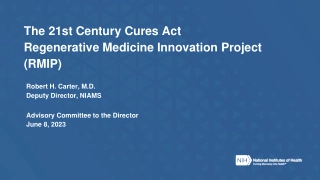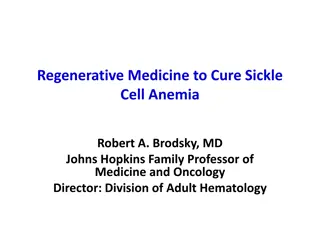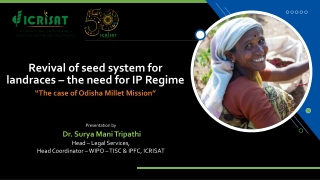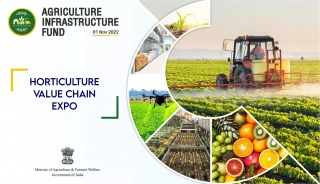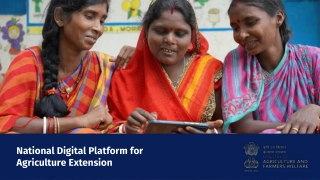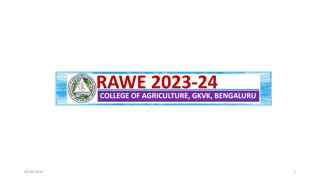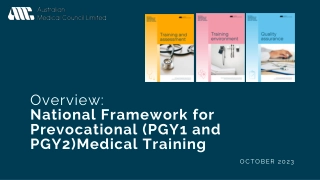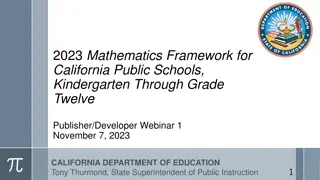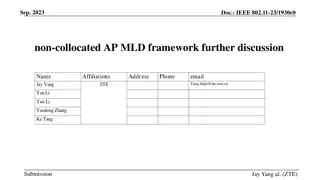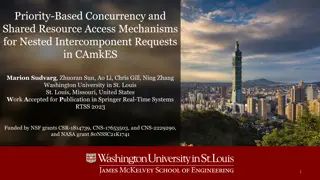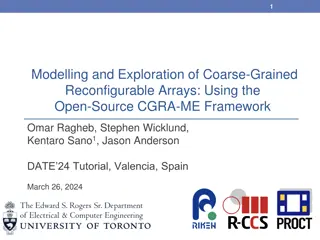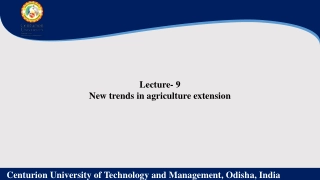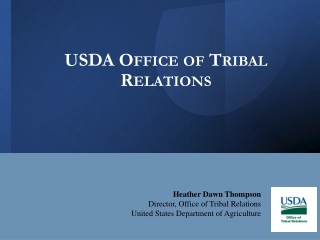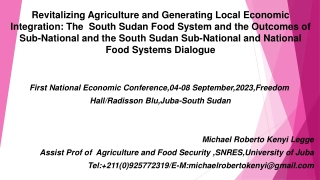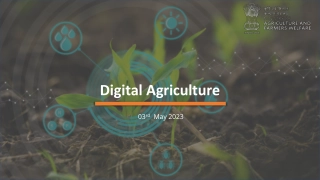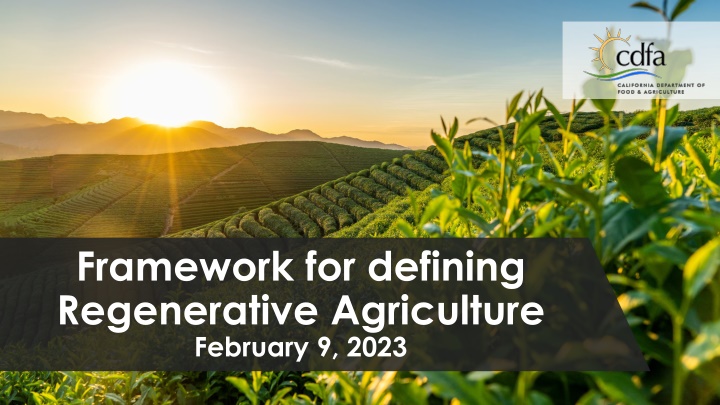
Framework for defining Regenerative Agriculture
This framework provides a comprehensive definition and approach to regenerative agriculture, highlighting the importance of enhancing soil health and maximizing ecosystem services. It addresses the complexity and interconnected nature of natural ecosystems while incorporating improvements to social and economic aspects of farm production. The framework also emphasizes the need to consider the intangible benefits experienced by farmers who practice regenerative agriculture.
Download Presentation
Please find below an Image/Link to download the presentation.
The content on the website is provided AS IS for your information and personal use only. It may not be sold, licensed, or shared on other websites without obtaining consent from the author. Download presentation by click this link. If you encounter any issues during the download, it is possible that the publisher has removed the file from their server.
- regenerative agriculture
- soil health
- ecosystem services
- sustainable food systems
- biodiversity
- water filtration
- nutrient cycling
Presentation Transcript
Framework for defining Regenerative Agriculture February 9, 2023
Background and purpose October letter from State Board of Food and Agriculture Asked for a literature review and framework definition by February 2023
December Discussion Expert panel Discussion focused on structures supporting agricultural systems including soil health (emphasizing soil biota and biodiversity)
Literature Review NRDC - Scientific Literature Review of Regenerative Agriculture Definitions, Practices, and Outcomes Proposed Definition: Regenerative agriculture is a system of crop and/or livestock production based in Indigenous knowledge that recognizes that natural ecosystems are complex networks that support farms and societies in multiple ways1. Through the lens of soil conservation, regenerative agriculture actively seeks to restore and improve the numerous2 provisioning, supporting, regulating, and cultural3 ecosystem services that society depends on 4 while operating within the natural resource constraints of a specific area. These ecosystem services include5 human health particularly farmworker health and safety, nutrient cycling, erosion prevention, biodiversity, and water filtration, and cultural services such as social connection and spiritual traditions that lead to social outcomes such as farmer wellbeing and farmer innovation. Both individual practices and groups of agricultural practices (including/such as organic farming) are regenerative if they help (NRDC, 2022) 1) That regenerative farming is context-dependent, 2) It acknowledges the complexity and interconnected nature of natural ecosystems, 3) It works to improve or regenerate natural ecosystems ability to provide vital services, and 4) It incorporates improvements to social and economic aspects of farm production.
Literature Review NRDC - Scientific Literature Review of Regenerative Agriculture Definitions, Practices, and Outcomes regenerative agriculture without acknowledging that it is driven and defined by the intangible benefits experienced by farmers that practice it, such as improved relationships among farming communities, surrounding neighbors, and consumers (NRDC, 2022). Questions to determine practice selection: 1. What is the problem to which Regenerative Agriculture is meant to be the solution? 2. What is to be regenerated? 3. What agronomic mechanism will enable or facilitate this regeneration? 4. Can this mechanism be integrated into an agronomic practice that is likely to be economically and socially viable in the specific context?
Literature Review Overview Regenerative Agriculture the soil is the base (RA) is a solution towards sustainable food systems A definition that allows for variability in location, cropping or livestock system, environment and farmer innovation Need for indicators to assess performance 28 articles, narrowed down from 279, attempted to define Regenerative Agriculture: Addressed various issues (soil health, climate change) and scales Definitions based on activities and objectives Activities: Operations/Implementation (Ex: farming practices) Objectives: Capture a desire to reach a certain goal
Literature Review Regenerative Agriculture The soil is the base Convergent Themes: Enhance and improve soil health (n=61%) Improve soil biodiversity (n=61%), Improve soil carbon (n=46%), soil physical quality (n=39%) a healthy soil is the basis for RA and therefore degraded agricultural soils should be restored to healthy soils Rhodes (2012, P.380) Optimize resource management (n=46%) Reducing waste and optimal nutrient availability Alleviate climate change / Improve water quality (n=29%) Reduce GHG emissions, improve water quality and availability Activities: Minimize external inputs, improving crop rotations, minimize tillage, using compost These activities direct towards a food system that builds on its ecological cycles and as a co-benefit reduces environmental externalities (L. Schreefel, et.al, 2020)
Literature Review Regenerative Agriculture The soil is the base Divergent Themes: Regenerate the System Vague description and did not define objectives Restore earth and Regenerate the natural system Improve human health Relating to providing goods for human health to ensure global food security showed high variability We can express that (RA) aims for sustainable food production Improve economic prosperity Referring to economic sustainability of farmers but lacked operations improves crop yields, long-term economic sustainability, and political-economic repositioning
Literature Review Regenerative Agriculture The soil is the base Conclusion: Regenerative Agriculture focuses on themes such as enhance and improve soil health, optimize resource management, alleviate climate change, improve nutrient cycling and water quality and availability Proposed Definition: approach to farming that uses soil conservation as the entry point to regenerate and contribute to multiple provisioning, regulating and supporting (Ecosystem) services, with the objective that this will enhance not only the environmental, but also the social and economic dimensions of sustainable food production.
Subcommittee Discussion February 17th Chair Dlott and members Dawley, Diggs, and Norris met with scientist Dana Yount and Deputy Secretary for Climate and Working Lands Virginia Jameson to further discuss the framework The group added language to specify that the definition should be applicable, relevant, and useful for California Agriculture The group added Leads to, Provides, Allows for, and Builds to existing framework guidelines Healthy Soils Program practices were added as examples that could help build soil health to support the last framework guideline The group wanted to keep California Agriculture as the main goal, focusing on how Regenerative Agriculture would impact producer to consumer
Draft Framework for Discussion Recommended concepts for Regenerative Agriculture definition: Applicable, Relevant and Useful for California Agriculture Leads to positive impacts on California s environmental, social, and economic goals, including climate goals Provides measurable and verifiable outcomes (keeping in mind variability throughout the state but should also be outcomes farmers and ranchers can easily measure/not economically burdensome to measure) Allows for context-specific outcomes (scale, geographic location, diverse and/or innovative agriculture systems, goals, etc.) Builds soil health (including elements of physical quality, carbon sequestered, and soil biodiversity, and alleviation of climate change) For example, practices funded by the CDFA Healthy Soils Program


